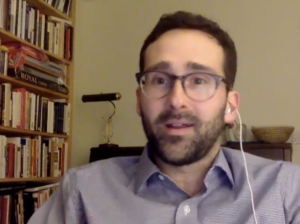by Jennifer Schrock
The Peace and Justice Support Network, Center for Sustainable Climate Solutions and Mennonite Creation Care Network co-hosted the first of multiple dialogs on the connections between militarism and environmental damage February 18.
 Luke Beck Kreider, an ethicist from the University of Virginia, provided input and led the conversation (pictured.) He recently completed a Ph.D. dissertation entitled “Theologies of Peace and Ecologies of Violence,” and his professional focus continues to straddle the environmental and peace-making fields.
Luke Beck Kreider, an ethicist from the University of Virginia, provided input and led the conversation (pictured.) He recently completed a Ph.D. dissertation entitled “Theologies of Peace and Ecologies of Violence,” and his professional focus continues to straddle the environmental and peace-making fields.
“I’m convinced that understanding the links between violence and the environment will be totally crucial to the pursuit of justice, peace and sustainability in the 21st century,” Beck Kreider said. He sees it as one of the primary arenas where churches will be called upon to live out their commitments to nonviolence.
Ecologies of violence
By ecologies of violence, Beck Kreider means that systems of violence are interconnected and flow through the natural world as well as directly harming humans. The relationship is as old as ancient peoples poisoning the wells and burning the crops of their enemies and as recent as the chemical and biological particulates that modern weapons introduce into water, air, soil and living beings. The ecological ripple effects of violence fan out through food chains and energy cycles, in rivers and on the wind.
Even if missiles are never used, war exercises, military industrial production and military land use all have significant environmental footprints. Kreider said that between 750,000 and 1.5 million square miles of land are devoted to military operations globally–a biophysical footprint larger than France and the United Kingdom combined.
Beck Kreider also sketched out the ways in which natural resources can be a source of conflict when there aren’t enough resources such as water to go around. Over 260 watersheds cross international political boundaries, and use of this water involves negotiations between 145 countries. Climate change can also compound the conditions for conflict when changes in the environment require people to migrate.
Firsthand experiences
Participants brought firsthand experiences to the discussion. Mary Sprunger-Froese of Colorado Springs, Colo., described a situation involving friends who had to abandon farming because the water became contaminated from firefighting foam that the military was using nearby.
SeongHan Kim, who joined the conversation from South Korea, reminded the group that U.S. militarism reaches far beyond U.S. soil. The U.S. operates more than 800 U.S. bases and military installations in over 70 countries. One such base in his own country is located on JeJu Island because of the island’s strategic location between China, South Korea and Japan. These bases often disrupt the life of the people on the ground.
“There is no such thing as an eco-friendly weapon or an energy-efficient missile,” Kim said.
Mark McReynolds of Fullerton, Calif., evoked footage of war torn cities where the camera pans across acres of concrete rubble, scattered bricks and shattered buildings. Scenes such as these are common in the news, but the fossil fuel energy required to rebuild destroyed structures is rarely mentioned. Manufacturing concrete requires enormous amounts of energy.
Several participants expressed frustration with the national reluctance to connect the dots between climate change and the military carbon footprint, even when climate change is recognized as a threat to national security. Beck Kreider emphasized that we are all embedded in the ecologies of violence that operate, and the lines between “us” and “them” are fuzzy.
“Our peace witness and how we relate to these ecologies of violence relates to our witness to Christ,” he concluded.
The next dialog on militarism and the environment is not yet scheduled, but a likely direction involves learning more from people directly affected by U.S. militarism–in the U.S. and abroad.
Meanwhile—as H.A. Penner of Akron, Pa., pointed out—tax season is a good time to consider war tax resistance and donate the percentage of one’s income tax that pays for war to peace-related causes.
